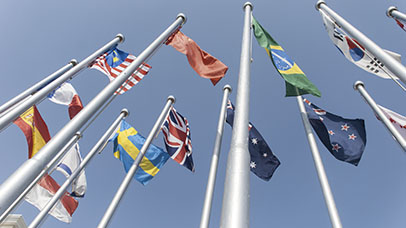How businesses are taxed
Governments use tax to raise revenues. Revenue agencies audit and collect these taxes.
Most businesses are subject to tax, regardless of whether they are multinational corporations or home-office enterprises. Businesses pay direct taxes to the government and they collect indirect taxes as a supplier of goods or services.
This report details our country-by-country report data for 2019, in line with the Organisation for Economic Co-operation and Development (OECD) standards. It includes the available data for countries and locations in which we have a taxable presence. The data includes corporate income tax paid, profit before tax and tangible assets.
Tax systems around the world vary and can be complex. However, the tax systems in places where Shell does business have some basic rules in common.
A. Most businesses pay corporate income tax where and when profits are made
Corporate income tax is typically due by law in countries where profits are made. This should correspond to where the business activity occurred. The tax due is determined by the tax system of the country or location where that activity took place. Governments design and apply tax rules to the profits generated in their countries and assess what is owed by businesses. Corporate income tax is payable on profits, not revenues. See the table "Simplified example of application of local tax law" for how tax rules are applied to calculate tax due.
Sometimes a multinational enterprise like Shell faces double taxation. This is when two countries seek to tax the same business income, resulting in a company being taxed twice. We believe that profit should only be taxed once, in line with the positions of the United Nations and the OECD.
|
Simplified example of application of local tax law |
$ |
|---|---|
|
Revenues |
2,500,000 |
|
Cost of operation |
(500,000) |
|
Cost of financing the business |
(150,000) |
|
Cost arising from equipment |
(175,000) |
|
Research and development |
(100,000) |
|
Profit before tax per the accounts |
1,575,000 |
|
|
|
|
Adjustment to accounting profit based on the application of local tax laws: |
|
|
Additional research & development tax relief |
(50,000) |
|
Additional tax relief for investment in new plant and machinery |
(50,000) |
|
Denial of deduction for some finance costs (for example perhaps relief is only available up to a certain percentage per year) |
25,000 |
|
|
|
|
Profits subject to tax |
1,500,000 |
|
Tax due at statutory tax rate of 25% |
375,000 |
|
Effective tax rate (375,000 / 1,575,000) |
23.8% |
In our Annual Report and Accounts we reported a corporate income tax charge of $9.1 billion on our 2019 profits. Our effective tax rate (ETR) is calculated by taking the tax charge of $9.1 billion as a percentage of total profits of $25.5 billion. In 2019, our ETR was 35.5%. For comparison, the average corporate income tax rate levied by the 36 countries that are members of the OECD was 23.5% [A].
Our ETR is higher than the average corporate income tax rate in OECD countries partly because many governments apply a higher corporate income tax rate to oil and gas activities. In some cases, this tax rate can be more than 80%. Our ETR is a blend of the different statutory tax rates applied to our various businesses and the different tax laws with which we have sought to comply.
The tax charge in our Annual Report and Accounts is the amount of corporate income tax we expect will be due on current-year profits, based on international accounting standards.
Profits are assessed by the tax authorities in the countries and locations where we are active. Shell’s global profit was $25.5 billion for 2019 and the corporate income tax we paid was $7.8 billion [B].
In most countries and locations, the corporate income tax we pay differs from the tax charge. This is often because some tax regimes require the payment of tax in arrears as well as in advance. Tax paid could include payments relating to previous years and partial payments relating to the current year.
- [A]
- Source: OECD Tax Database (2019), Table II.1. Statutory corporate income tax rate.
- [B]
- Comprising $7.6 billion taxes paid disclosed as cash flow from operations and $0.2 billion as cash flow from investments.
B. Tax generates revenue for governments
Tax revenues enable governments to pay for public services, such as education, health care and transport. Governments set their fiscal policies and the rules for individual and business taxes. Tax treatments — such as tax rates, reliefs, exemptions and allowances or disallowances — are typically approved by national parliaments. Companies must comply with relevant tax laws. Audits and controls by tax authorities help to check whether companies are compliant.
Governments can use targeted tax incentives for specific policy objectives, such as protecting the environment, reducing carbon emissions or encouraging advances in areas like research and development. Governments often design incentives to attract domestic and international investment, which can boost economies, create jobs and develop communities. When available and appropriate, we use tax incentives and exemptions where we have a qualifying business activity.
Some governments may choose to lower specific taxes, like corporate income tax. These are deliberate policy decisions and not unintended tax loopholes. Such incentives are designed by governments to attract investment in areas where development may benefit their countries. When governments offer such incentives, they may expect to raise revenues through other types of taxes, such as employment taxes or export duties.
C. Companies pay and collect a range of taxes
Companies pay and collect a range of taxes. These include:
- Corporate income tax -- direct tax on profits, after operating costs have been deducted from revenues.
- Value-added tax (VAT) – indirect tax due on the purchase of goods and services, typically as a percentage of the sales price of the item or service. The companies that charge the VAT administer collection and payment on behalf of governments.
- Employment tax – companies routinely collect income taxes on employees’ salaries and pay these taxes to the government.
- Excise duty – an indirect tax on manufacturers due at the point of production rather than sale, which generally forms part of the cost of the product.
- Customs duty – an indirect tax imposed on goods as they either enter or leave a country.
According to 2019 figures from the OECD, a government’s largest source of revenue typically arises from employment taxes, which include personal income tax, payroll taxes and social security contributions. Most employment taxes are paid by employees but some are paid by companies. Governments also generate revenue through indirect taxes on products and services, often as consumption taxes paid by consumers but in some cases also by businesses. These include non-recoverable VAT, customs, excise and other duties.
When a business collects indirect taxes on behalf of a government, it carries the cost of gathering the financial data, preparing reports and executing payments. This process helps governments collect taxes more efficiently because it is easier to collect VAT from businesses than from individual consumers.
OECD data on the average split of member countries’ tax revenues shows that corporate income tax raises around 9% of total tax revenues.
Governments collect different types of taxes
Companies operating in the oil and gas industry also contribute to public finances by paying royalties, bonuses, fees, and a host government’s production entitlements. For example, in 2019 we paid $10.3 billion in production entitlements. This is more than we paid in corporate income tax.
Our Payments to Governments Report shows how we directly contributed to public finances in 2019 as a result of our exploration and production activities.
This report focuses on corporate income tax as this tax has attracted interest from investors, non-governmental organisations and wider society.
D. More information on what we do
Inputs [A]
Financial
- 404,336 Total assets ($ million) [B]
- 28,788 Capital investment ($ million)
- 37,893 Operating expenses ($ million)
- 43,000 Tax returns filed
Our people
- 83,000 Number of employees [C]
- 6,900 New hires
- 13,209 Total employee costs ($ million) [D]
Societal engagement
- 29,000 Suppliers of goods and services
- 100% Joint ventures and suppliers aligned with Shell General Business Principles and Code of Conduct
- 223 R&D projects started with universities
Our business activities
- Exploration
- Development and extraction
- Manufacturing and energy production
- Transport and trading
- Sales and marketing
- Technical and business services
 For a more detailed discussion see our business activities
For a more detailed discussion see our business activitiesOutcome and impact [A]
Financial
- 352,106 Total revenue and other income ($ million)
- 25,485 Profit before taxes ($ million)
- 9,053 Income tax charge ($ million)
- 25,386 Shareholder distributions ($ million)
Our people
- 26.4% Women in senior leadership positions [B]
- 78 Average employee engagement score
- 31% Female employees
Societal engagement
- 344 Shell Foundation grant funding since 2000 ($ million)
- 84 Social investment in lower-income countries ($ million)
- #1 Brand ranking in 50 out of 63 countries [E]
- [A]
- In 2019 unless stated otherwise.
- [B]
- At December 31, 2019.
- [C]
- At December 31, 2019, excluding a further 4,000 employees in certain New Energies and Downstream companies.
- [D]
- Excludes employees seconded to joint ventures and associates.
- [E]
- Source: Kantar Global Retail Tracker (GRT) – Shell analysis based on GRT, an independent survey conducted by Kantar across 63 markets in 2019.
 Message from the Chief Financial Officer
Message from the Chief Financial Officer
 Shell’s approach to taxes
Shell’s approach to taxes
 Special topics
Special topics
 Our tax data
Our tax data
